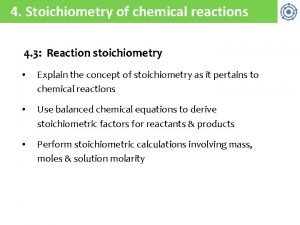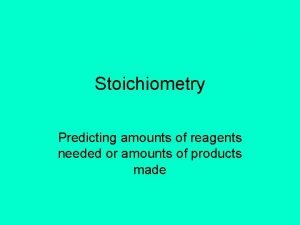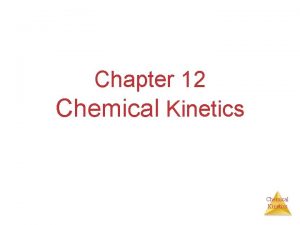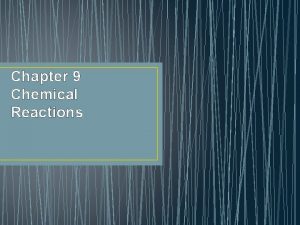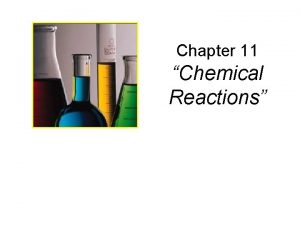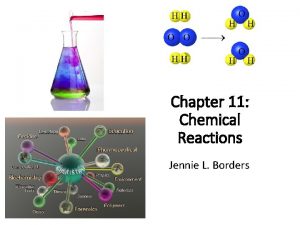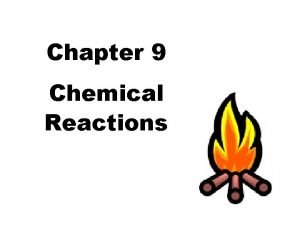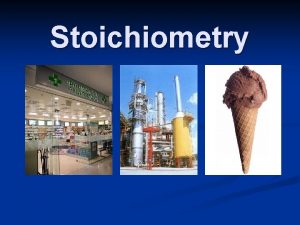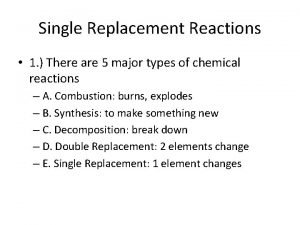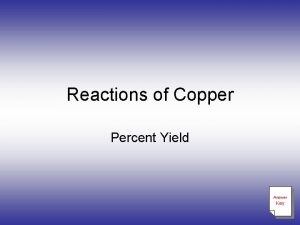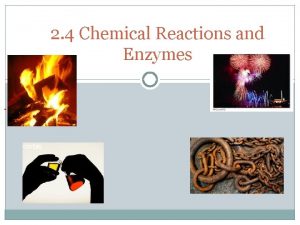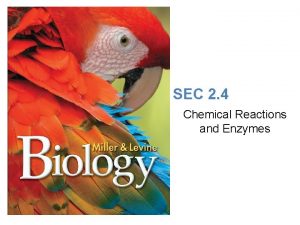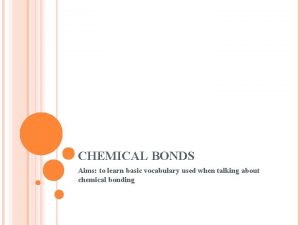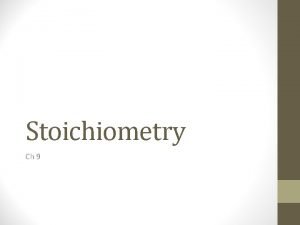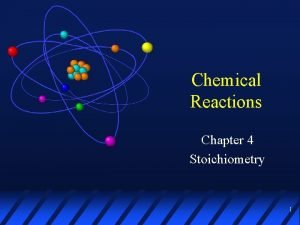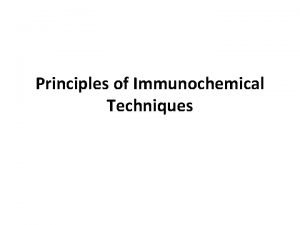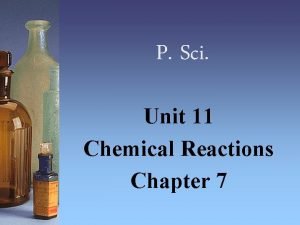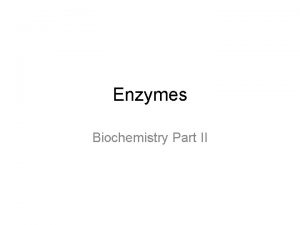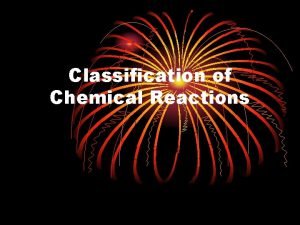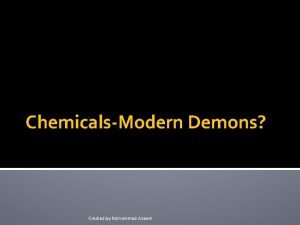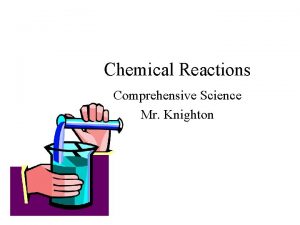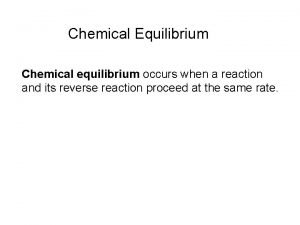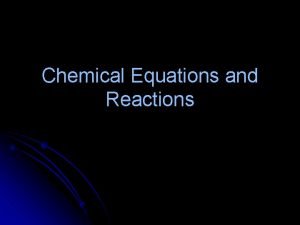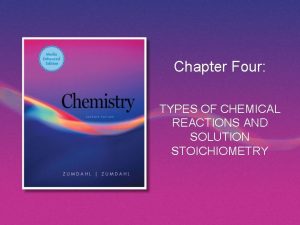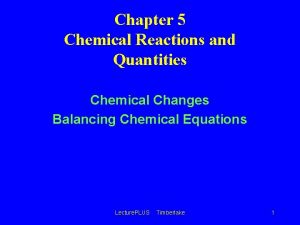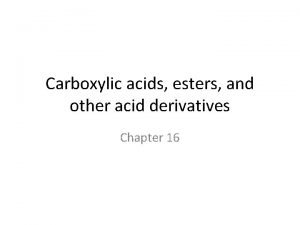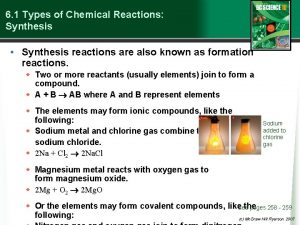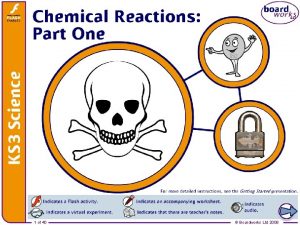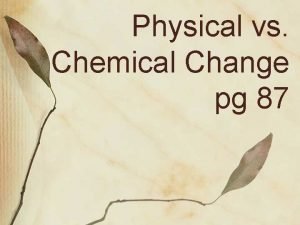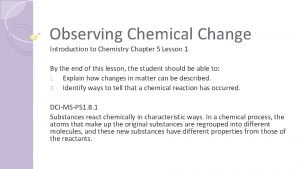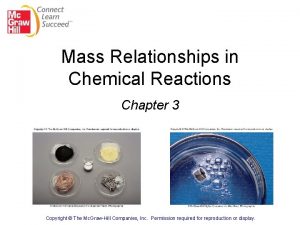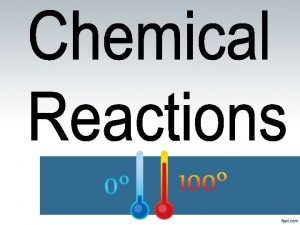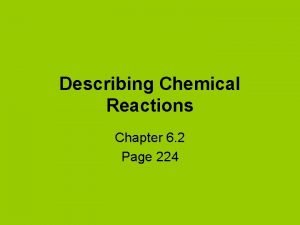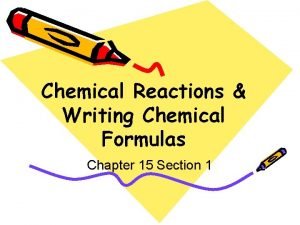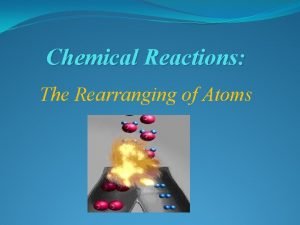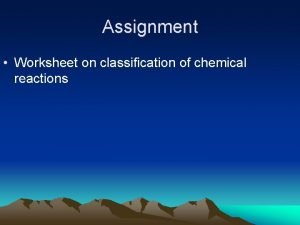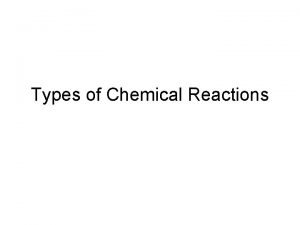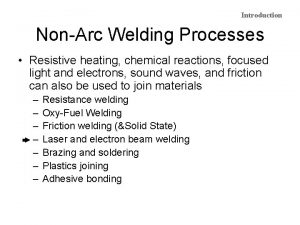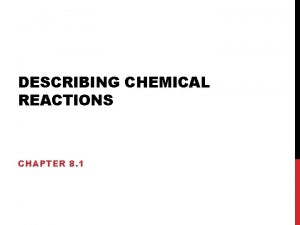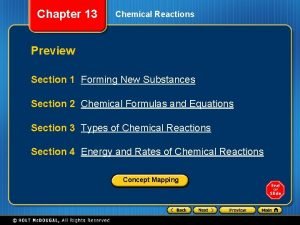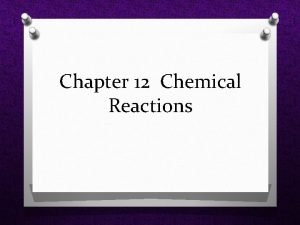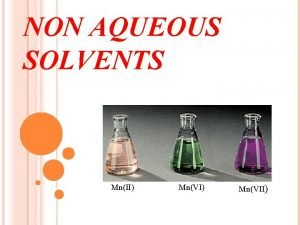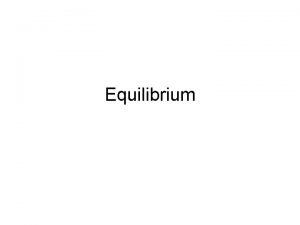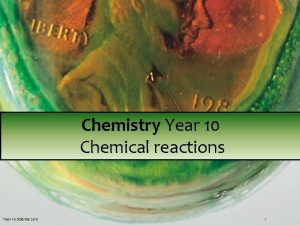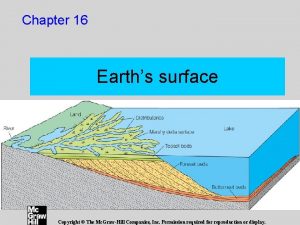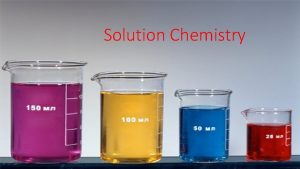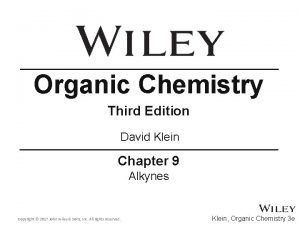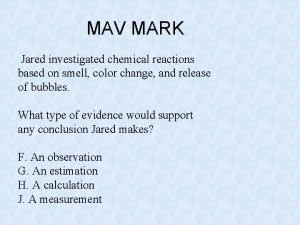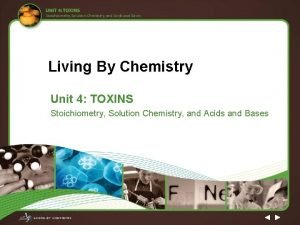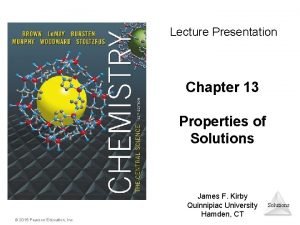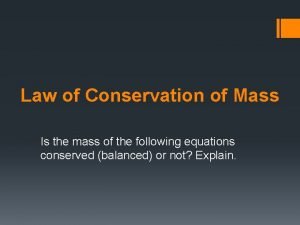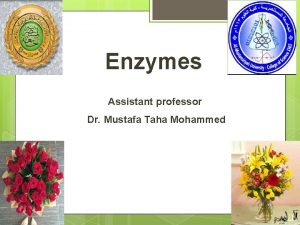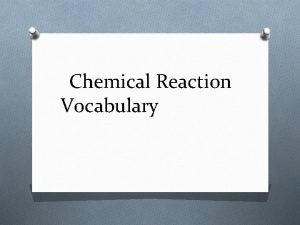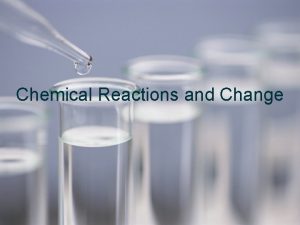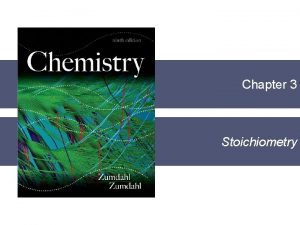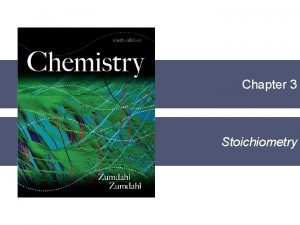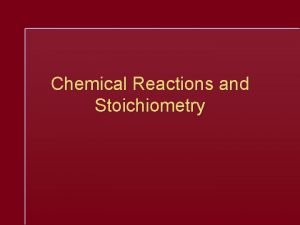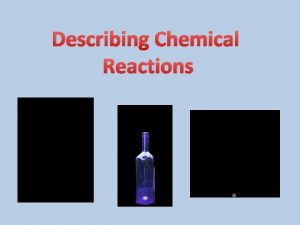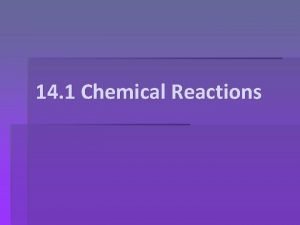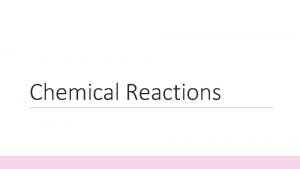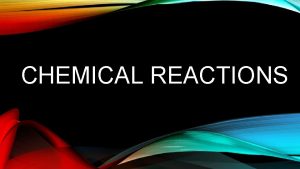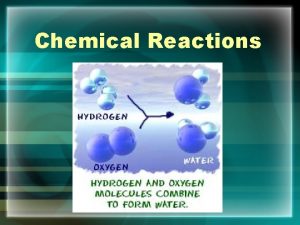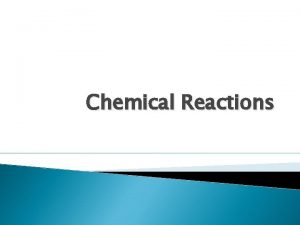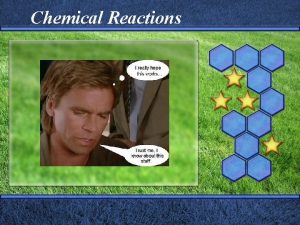Chapter 3 Chemical Reactions and Reaction Stoichiometry 3







































































































- Slides: 103

Chapter 3 Chemical Reactions and Reaction Stoichiometry

3. 1 Chemical Equations

Law of Conservation of Mass “We may lay it down as an incontestable axiom that, in all the operations of art and nature, nothing is created; an equal amount of matter exists both before and after the experiment. Upon this principle, the whole art of performing chemical experiments depends. ” --Antoine Lavoisier, 1789

Chemical Equations Chemical equations are concise representations of chemical reactions.

Anatomy of a Chemical Equation CH 4 (g) + 2 O 2 (g) CO 2 (g) + 2 H 2 O (g)

Anatomy of a Chemical Equation CH 4 (g) + 2 O 2 (g) CO 2 (g) + 2 H 2 O (g) Reactants appear on the left side of the equation.

Anatomy of a Chemical Equation CH 4 (g) + 2 O 2 (g) CO 2 (g) + 2 H 2 O (g) Products appear on the right side of the equation.

Anatomy of a Chemical Equation CH 4 (g) + 2 O 2 (g) CO 2 (g) + 2 H 2 O (g) The states of the reactants and products are written in parentheses to the right of each compound.

Anatomy of a Chemical Equation CH 4 (g) + 2 O 2 (g) CO 2 (g) + 2 H 2 O (g) Coefficients are inserted to balance the equation.

Subscripts and Coefficients Give Different Information • Subscripts tell the number of atoms of each element in a molecule.

Subscripts and Coefficients Give Different Information • Subscripts tell the number of atoms of each element in a molecule • Coefficients tell the number of molecules.

Why Do We Add Coefficients Instead of Changing Subscripts to Balance? • Hydrogen and oxygen can make water OR hydrogen peroxide: Ø 2 H 2(g) + O 2(g) → 2 H 2 O(l) Ø H 2(g) + O 2(g) → H 2 O 2(l)

In the molecular level views shown in the figure how many C, H, and O atoms are present on the reactant side? Are the same number of each type of atom present on the product side? a. 18 b. 14 c. 6 d. 4

Sample Exercise 3. 1 Interpreting and Balancing Chemical Equations The following diagram represents a chemical reaction in which the red spheres are oxygen atoms and the blue spheres are nitrogen atoms. (a) Write the chemical formulas for the reactants and products. (b) Write a balanced equation for the reaction. (c) Is the diagram consistent with the law of conservation of mass?

Practice Exercise 1 In the following diagram, the white spheres represent hydrogen atoms, and the blue spheres represent nitrogen atoms. To be consistent with the law of conservation of mass, how many NH 3 molecules should be shown in the right box?

Practice Exercise 2: White spheres are H, black are C and red are O. Ethylene, C 2 H 4 and oxygen, O 2 (not shown) are reactants and CO 2 and H 2 O are products. A) Write a balanced chemical equation for the reaction. B) Determine the number of O 2 molecules that should be shown.

Sample Exercise 3. 2 & Practice Exercises • Na + H 2 O → Na. OH + H 2 • CH 4 + Br 2 → CBr 4 + HBr • Fe + O 2 → Fe 2 O 3 • Al + HCl → Al. Cl 3 + H 2 • Ca. CO 3 + HCl → Ca. Cl 2 + CO 2 + H 2 O

How many atoms of Mg, O, and H are represented by the notation 3 Mg(OH)2? a. 1 Mg, 2 O, and 2 H b. 2 Mg, 2 O, and 2 H c. 6 Mg, 6 O, and 6 H d. 3 Mg, 6 O, and 6 H

3. 2 Simple Patterns of Chemical Reactivity

Combination Reactions • In this type of reaction two or more substances react to form one product. • Examples: – 2 Mg (s) + O 2 (g) 2 Mg. O (s) – N 2 (g) + 3 H 2 (g) 2 NH 3 (g) – C 3 H 6 (g) + Br 2 (l) C 3 H 6 Br 2 (l)

When Na and S undergo a combination reaction, what is the chemical formula of the product? a. Na. S b. Na. S 2 c. Na 2 S d. Na 2 S 2

Decomposition Reactions • In a decomposition one substance breaks down into two or more substances. • Examples: – Ca. CO 3 (s) Ca. O (s) + CO 2 (g) – 2 KCl. O 3 (s) 2 KCl (s) + O 2 (g) – 2 Na. N 3 (s) 2 Na (s) + 3 N 2 (g)

Sample Exercise 3. 3 1) Write an equation for lithium metal reacting with fluorine gas. 2) Write an equation for the decomposition of solid barium carbonate (it produces a solid and a gas) 3) Write an equation for the decomposition of mercury (II) oxide. 4) Aluminum metal undergoes a combination reaction with oxygen in the air.

Practice Exercise 1 Which of the following reactions is the balanced equation that represents the decomposition reaction that occurs when silver (I) oxide is heated? (a) Ag. O(s) → Ag(s) + O(g); (b) 2 Ag. O(s) → 2 Ag(s) + O 2(g); (c) Ag 2 O(s) → 2 Ag(s) + O 2 (g); (d) 2 Ag 2 O(s) → 4 Ag(s) + O 2 (g); (e) Ag 2 O(s) → 4 Ag(s) + O 2(g);

Combustion Reactions • Examples: • These are generally rapid reactions that produce a flame. • Most often involve hydrocarbons reacting with oxygen in the air. – CH 4 (g) + 2 O 2 (g) CO 2 (g) + 2 H 2 O (g) – C 3 H 8 (g) + 5 O 2 (g) 3 CO 2 (g) + 4 H 2 O (g)

Does this reaction (Figure 3. 8) produce or consume thermal energy (heat)? a. Consumes heat b. Produces heat

Sample Exercise 3. 4 1) Write an equation for the reaction that occurs when methanol (CH 3 OH) is burned in air. 2) Write an equation for the reaction that occurs when ethanol (C 2 H 5 OH) is burned in air.

Practice Exercise 1 Write the balanced equation for the reaction that occurs when ethylene glycol, C 2 H 4(OH) 2, burns in air. (a) (b) (c) (d) (e) C 2 H 4(OH)2(l) + 5/2 O 2(g) → 2 CO 2(g) + 3 H 2 O(g) 2 C 2 H 4(OH)2(l) + 5 O 2(g) → 4 CO 2(g) + 6 H 2 O(g) C 2 H 4(OH)2(l) + 3 O 2(g) → 2 CO 2(g) + 3 H 2 O(g) C 2 H 4(OH)2(l) + 5 O 2(g) → 2 CO 2(g) + 3 H 2 O(g) 4 C 2 H 4(OH)2(l) + 10 O 2(g) → 8 CO 2(g) + 12 H 2 O(g)

3. 3 Formula Weights

Formula Weight (FW) • A formula weight is the sum of the atomic weights for the atoms in a chemical formula. • So, the formula weight of calcium chloride, Ca. Cl 2, would be Ca: 1(40. 1 amu) + Cl: 2(35. 5 amu) 111. 1 amu • Formula weights are generally reported for ionic compounds.

Molecular Weight (MW) • A molecular weight is the sum of the atomic weights of the atoms in a molecule. • For the molecule ethane, C 2 H 6, the molecular weight would be C: 2(12. 0 amu) + H: 6(1. 0 amu) 30. 0 amu

Sample Exercise 3. 5 • Calculate the formula weight of: – A) sucrose (C 12 H 22 O 11) – B) calcium nitrate, Ca(NO 3)2 – C) Al(OH)3 – D) CH 3 OH – E) Ta. ON

Practice Exercise 1 Which of the following is the correct formula weight for calcium phosphate? (a) 310. 2 amu (b) 135. 1 amu (c) 182. 2 amu (d) 278. 2 amu (e) 175. 1 amu

Percent Composition One can find the percentage of the mass of a compound that comes from each of the elements in the compound by using this equation: % element = (number of atoms)(atomic weight) (FW of the compound) x 100

Percent Composition So the percentage of carbon in ethane (C 2 H 6) is… %C = (2)(12. 0 amu) (30. 0 amu) 24. 0 amu x 100 = 30. 0 amu = 80. 0%

Sample Exercise 3. 6 • 1) Calculate the percent by mass of all elements in sucrose (C 12 H 22 O 11). • 2) Calculate the percent of potassium, by mass, in K 2 Pt. Cl 6.

Practice Exercise 1 What is the percentage of nitrogen, by mass, in calcium nitrate? (a) 8. 54% (b) 17. 1% (c) 13. 7% (d) 24. 4% (e) 82. 9%.

3. 4 Avogadro’s Number and the Mole

Avogadro’s Number • 6. 02 x 1023 • 1 mole of 12 C has a mass of 12 g.

Sample Exercise 3. 7 • Without a calculator, arrange the following in order of increasing numbers of carbon atoms: 12 g 12 C, 1 mol C 2 H 2, 9 x 1023 molecules CO 2 • Arrange in order of increasing number of oxygen atoms: 1 mol H 2 O, 1 mol CO 2, 3 x 1023 molecules O 3

Practice Exercise 1 Determine which of the following samples contains the fewest sodium atoms? (a) 1 mol sodium oxide (b) 45 g sodium fluoride (c) 50 g sodium chloride (d) 1 mol sodium nitrate?

Sample Exercise 3. 8 Converting Moles to Atoms Calculate the number of H atoms in 0. 350 mol of C 6 H 12 O 6.

Practice Exercises 1 & 2 • How many sulfur atoms are in: – A) 0. 45 mol Ba. SO 4 – B) 1. 10 mol aluminum sulfide • How many oxygen atoms are in: – A) 0. 25 mol Ca(NO 3)2 – B) 1. 50 mol sodium carbonate

Molar Mass • By definition, a molar mass is the mass of 1 mol of a substance (i. e. , g/mol). – The molar mass of an element is the mass number for the element that we find on the periodic table. – The formula weight (in amu’s) will be the same number as the molar mass (in g/mol).

How many H 2 O molecules are in a 9. 00 -g sample of water? a. 0. 500 b. 3. 01 × 1023 c. 2. 71 × 1024 d. 1. 08 × 1023

Which has more mass, a mole of water (H 2 O) or a mole of glucose (C 6 H 12 O 6)? a. Mole of glucose b. Mole of water

Which contains more molecules, a mole of water or a mole of glucose? a. Mole of water b. Mole of glucose c. Requires Avogadro’s number to answer question d. They both contain the same number of molecules

Using Moles provide a bridge from the molecular scale to the real-world scale.

Mole Relationships • One mole of atoms, ions, or molecules contains Avogadro’s number of those particles. • One mole of molecules or formula units contains Avogadro’s number times the number of atoms or ions of each element in the compound.

Sample Exercise 3. 9 • What is the molar mass of glucose, C 6 H 12 O 6? • Calculate the molar mass of Ca(NO 3)2.

Practice Exercise 1 A sample of an ionic compound containing iron and chlorine is analyzed and found to have a molar mass of 126. 8 g/mol. What is the charge of the iron in this compound? (a) 1+ (b) 2+ (c) 3+ (d) 4+

Sample Exercise 3. 10 & Practice Exercises Calculate the number of moles of glucose (C 6 H 12 O 6) in 5. 380 g of C 6 H 12 O 6. How many moles of sodium bicarbonate are in 508 g of Na. HCO 3? How many moles of water are in 1. 00 L of water, whose density is 1. 00 g/m. L?

Sample Exercise 3. 11 & Practice Exercises Calculate the mass, in grams, of 0. 433 mol of calcium nitrate. What is the mass in grams of 6. 33 mol Na. HCO 3? What is the mass in grams of 3. 0 x 10 -5 mol of sulfuric acid? What is the mass in grams of 0. 50 mol diamond (C)? What is the mass in grams of 0. 155 mol of ammonium chloride?

What number would you use to convert (a) moles of CH 4 to grams of CH 4 grams and (b) number of molecules of CH 4 to moles of CH 4? a. b. c. d. Avogadro’s number, 6. 02 × 1023 particles/mol Inverse of molar mass of CH 4, 1 mol CH 4/16. 0 g CH 4 Molar mass of CH 4, 16. 0 g CH 4/1 mol CH 4 Formula weight of CH 4, 16. 0 amu

Sample Exercise 3. 12 Calculating the Number of Molecules and Number of Atoms from Mass (a) How many glucose molecules are in 5. 23 g of C 6 H 12 O 6? How many oxygen atoms are in this sample? (b) How many nitric acid molecules are in 4. 20 g HNO 3? How many O atoms are in this sample?

Practice Exercise 1 How many chlorine atoms are in 12. 2 g of CCl 4? (a) 4. 77 × 1022 (b) 7. 34 × 1024 (c) 1. 91 × 1023 (d) 2. 07 × 1023

3. 5 Empirical Formulas from Analyses

Calculating Empirical Formulas One can calculate the empirical formula from the percent composition.

Calculating Empirical Formulas The compound para-aminobenzoic acid (you may have seen it listed as PABA on your bottle of sunscreen) is composed of carbon (61. 31%), hydrogen (5. 14%), nitrogen (10. 21%), and oxygen (23. 33%). Find the empirical formula of PABA.

Calculating Empirical Formulas Assuming 100. 00 g of para-aminobenzoic acid, C: H: N: O: 1 mol 12. 01 g 1 mol 5. 14 g x 1. 01 g 1 mol 10. 21 g x 14. 01 g 1 mol 23. 33 g x 16. 00 g 61. 31 g x = 5. 105 mol C = 5. 09 mol H = 0. 7288 mol N = 1. 456 mol O

Calculating Empirical Formulas Calculate the mole ratio by dividing by the smallest number of moles: C: 5. 105 mol 0. 7288 mol = 7. 005 7 H: 5. 09 mol 0. 7288 mol = 6. 984 7 N: 0. 7288 mol = 1. 000 O: 1. 458 mol 0. 7288 mol = 2. 001 2

Calculating Empirical Formulas These are the subscripts for the empirical formula: C 7 H 7 NO 2

Could the empirical formula determined from chemical analysis be used to tell the difference between acetylene, C 2 H 2, and benzene, C 6 H 6? a. Yes, because the empirical formula is specific to the molecule. b. Yes, because the empirical formula tells the number of atoms in the molecule. c. No, because the empirical formula cannot be determined for a liquid. d. No, because the empirical formulas for C 2 H 2 and C 6 H 6 will be the same.

Sample Exercise 3. 13 • 1) Ascorbic acid (Vitamin C) contains 40. 92% C, 4. 58% H, and 54. 50% O by mass. What is the empirical formula of ascorbic acid? • 2) A 5. 325 -g sample of methyl benzoate, a compound used in manufacturing perfumes, is found to contain 3. 758 g of carbon, 0. 316 g of hydrogen, and 1. 251 g of oxygen. What is the empirical formula of this substance?

Practice Exercise 1 A 2. 144 -g sample of phosgene, a compound used as a chemical warfare agent during World War I, contains 0. 260 g of carbon, 0. 347 g of oxygen, and 1. 537 g of chlorine. What is the empirical formula of this substance? (a) CO 2 Cl 6 (b) COCl 2 (c) C 0. 022 O 0. 022 Cl 0. 044 (d) C 2 OCl 2

Molecular Formula • Is a multiple of the empirical formula • The multiple can be found by comparing the empirical formula weight with the molecular weight.

Sample Exercise 3. 14 • 1) Mesitylene, a hydrocarbon in crude oil, has an empirical formula of C 3 H 4. The experimentally determined molecular weight is 121 amu. What is the molecular formula? • 2) Ethylene glycol, used in antifreeze, is 38. 7% C, 9. 7% H, and 51. 6% O by mass. Its molar mass is 62. 1 g/mol. What are the empirical and molecular formulas?

Practice Exercise 1 Cyclohexane, a commonly used organic solvent, is 85. 6% C and 14. 4% H by mass with a molar mass of 84. 2 g/mol. What is its molecular formula? (a) C 6 H (b) CH 2 (c) C 5 H 24 (d) C 6 H 12 (e) C 4 H 8

Combustion Analysis • Compounds containing C, H and O are routinely analyzed through combustion in a chamber like this. – C is determined from the mass of CO 2 produced. – H is determined from the mass of H 2 O produced. – O is determined by difference after the C and H have been determined.

Elemental Analyses Compounds containing other elements are analyzed using methods analogous to those used for C, H and O. © 2009, Prentice-Hall, Inc.

Sample Exercise 3. 15 Determining Empirical Formula by Combustion Analysis Isopropyl alcohol, a substance sold as rubbing alcohol, is composed of C, H, and O. Combustion of 0. 255 g of isopropyl alcohol produces 0. 561 g of CO 2 and 0. 306 g of H 2 O. Determine the empirical formula of isopropyl alcohol.

In Sample Exercise 3. 15, how do you explain that the values in our calculated C: H: O ratio are 3. 0: 7. 9: 1. 0 rather than exact integers 3: 8: 1? a. An incorrect molar mass for carbon is used in the problem. b. Approximations are used in the problem. c. An incorrect number of significant figures is used in the problem. d. Experimental uncertainties in the experimental measurements.

Practice Exercise 1 The compound dioxane, which is used as a solvent in various industrial processes, is composed of C, H, and O atoms. Combustion of a 2. 203 -g sample of this compound produces 4. 401 g CO 2 and 1. 802 g H 2 O. A separate experiment shows that it has a molar mass of 88. 1 g/mol. Which of the following is the correct molecular formula for dioxane? (a) C 2 H 4 O, (b) C 4 H 4 O 2, (c) CH 2, (d) C 4 H 8 O 2

Practice Exercise 2 • 1) Caproic acid, which is responsible for the foul odor of dirty socks, is composed of C, H, and O. Combustion of a 0. 225 g sample produces 0. 512 g CO 2 and 0. 209 g H 2 O. What is the empirical formula of caproic acid? • 2) If caproic acid has a molar mass of 116 g/mol, what is its molecular formula?

3. 6 Quantitative Information from Balanced Equations

Stoichiometric Calculations The coefficients in the balanced equation give the ratio of moles of reactants and products.

When 1. 57 mol O 2 reacts with H 2 to form H 2 O, how many moles of H 2 are consumed in the process? a. 1. 57 mol b. 3. 14 mol c. 6. 28 mol d. 9. 42 mol

1. 00 g of C 4 H 10 reacts with 3. 59 g of O 2 to form 3. 03 g of CO 2. Using only addition and subtraction, calculate the amount of H 2 O produced. a. 1. 56 g H 2 O b. 3. 12 g H 2 O c. 5. 00 g H 2 O d. 7. 62 g H 2 O

Stoichiometric Calculations We have already seen in this chapter how to convert from grams to moles or moles to grams. The NEW calculation is how to compare two DIFFERENT materials, using the MOLE RATIO from the balanced equation!

Sample Exercise 3. 16 • How many grams of water can be produced from 1. 00 g of glucose? C 6 H 12 O 6(s) + 6 O 2(g) → 6 CO 2(g) + 6 H 2 O(l) • There is 1. 00 g of glucose to start. • The first step is to convert it to moles.

Sample Exercise 3. 16 • The NEW calculation is to convert moles of one substance in the equation to moles of another substance. • The MOLE RATIO comes from the balanced equation.

Sample Exercise 3. 16 • Then turn the moles of water to grams using molar mass

Practice Exercise 1 Sodium hydroxide reacts with carbon dioxide to form sodium carbonate and water: 2 Na. OH(s) + CO 2(g) → Na 2 CO 3(s) + H 2 O(l) How many grams of Na 2 CO 3 can be prepared from 2. 40 g of Na. OH? (a) 3. 18 g (b) 6. 36 g (c) 1. 20 g (d) 0. 0300 g

Practice Exercise 2 • 1) 2 KCl. O 3 → 2 KCl + O 2 – A) How many grams of O 2 can be prepared from 4. 50 g of KCl. O 3? – B) How many moles of O 2 can be produced from 2. 5 moles of KCl. O 3? – C) How many moles of KCl can be produced from 3. 67 g of KCl. O 3?

Sample Exercise 3. 17 Solid lithium hydroxide is used in space vehicles to remove exhaled carbon dioxide. Lithium hydroxide reacts with gaseous carbon dioxide to form solid lithium carbonate and liquid water. How many grams of carbon dioxide can be absorbed by 1. 00 g of lithium hydroxide?

Practice Exercise 1 Propane, C 3 H 8, is a common fuel used for cooking and home heating. What mass of O 2 is consumed in the combustion of 1. 00 g of propane? a) 5. 00 g b) 0. 726 g c) 2. 18 g d) 3. 63 g

Practice Exercise 2 Methanol, CH 3 OH, reacts with oxygen from air in a combustion reaction to form water and carbon dioxide. What mass of water is produced in the combustion of 23. 6 g of methanol?

3. 7 Limiting Reactants

How Many Cookies Can I Make? • You can make cookies until you run out of one of the ingredients. • Once this family runs out of sugar, they will stop making cookies (at least any cookies you would want to eat).

How Many Cookies Can I Make? • In this example the sugar would be the limiting reactant, because it will limit the amount of cookies you can make.

Limiting Reactants • The limiting reactant is the reactant present in the smallest stoichiometric amount. – In other words, it’s the reactant you’ll run out of first (in this case, the H 2).

Limiting Reactants In the example below, the O 2 would be the excess reagent.

If the amount of H 2 is doubled, how many moles of H 2 O would have formed? a. 10 mol H 2 O b. 12 mol H 2 O c. 14 mol H 2 O d. 20 mol H 2 O

Sample Exercise 3. 18 • 1) Given N 2 + 3 H 2 → 2 NH 3, how many moles of NH 3 can be formed from 3. 0 mol of N 2 and 6. 0 mol of H 2? • 2) In the equation 2 Al + 3 Cl 2 → 2 Al. Cl 3, 1. 50 mol of Al reacts with 3. 00 mol Cl 2. – A) Which reactant is the limiting reactant? – B) How many moles of Al. Cl 3 are formed? – C) How many moles of excess reactant are left over at the end of the reaction?

Practice Exercise 1 When 24 mol of methanol and 15 mol of oxygen combine in the combustion reaction 2 CH 3 OH(l) + 3 O 2(g) → 2 CO 2(g) + 4 H 2 O(g), what is the excess reactant and how many moles of it remains at the end of the reaction? (a) 9 mol CH 3 OH(l) (b) 10 mol CO 2(g) (c) 10 mol CH 3 OH(l) (d) 14 mol CH 3 OH(l) (e) 1 mol O 2(g)

Sample Exercise 3. 19 Calculating the Amount of Product Formed from a Limiting Reactant Consider the following reaction that occurs in a fuel cell: 2 H 2(g) + O 2 (g) → 2 H 2 O (g) This reaction, properly done, produces energy in the form of electricity and water. Suppose a fuel cell is set up with 150 g of hydrogen gas and 1500 grams of oxygen gas (each measurement is given with two significant figures). How many grams of water can be formed?

Practice Exercise 1 Molten gallium reacts with arsenic to form the semiconductor, gallium arsenide, Ga. As, used in light–emitting diodes and solar cells: Ga(l) + As(s) → Ga. As(s) If 4. 00 g of gallium is reacted with 5. 50 g of arsenic, how many grams of the excess reactant are left at the end of the reaction? (a) 1. 20 g As, (b) 1. 50 g As (c) 4. 30 g As, or (d) 8. 30 g Ga

Practice Exercise 2 Zn + 2 Ag. NO 3 → 2 Ag + Zn(NO 3)2 – 2. 00 g of zinc is placed in an aqueous solution containing 2. 50 g of silver nitrate. Which reactant is limiting? – How many grams of silver will form? – How many grams of Zn(NO 3)2 will form? – How many grams of excess reactant will be left over?

Theoretical Yield • The theoretical yield is the maximum amount of product that can be made. – In other words it’s the amount of product possible as calculated through the stoichiometry problem. • This is different from the actual yield, which is the amount one actually produces and measures.

Percent Yield One finds the percent yield by comparing the amount actually obtained (actual yield) to the amount it was possible to make (theoretical yield). Actual Yield Percent Yield = x 100 Theoretical Yield

Sample Exercise 3. 20 Calculating Theoretical Yield and Percent Yield Adipic acid, H 2 C 6 H 8 O 4, used to produce nylon, is made commercially by a reaction between cyclohexane (C 6 H 12) and O 2: 2 C 6 H 12 (l) + 5 O 2(g) → 2 H 2 C 6 H 3 O 4(l) + 2 H 2 O(g) (a) Assume that you carry out this reaction with 25. 0 g of cyclohexane and that it is the limiting reactant. What is theoretical yield of adipic acid? (b) If you obtain 33. 5 g of adipic acid, what is the percent yield?

Practice Exercise 1 If 3. 00 g of titanium metal is reacted with 6. 00 g of chlorine gas, Cl 2, to form 7. 7 g of titanium (IV) chloride in a combination reaction, what is the percent yield of the product? (a) 65% (b) 96% (c) 48% (d) 86%

Practice Exercise 2 Fe 2 O 3 + 3 CO → 2 Fe + 3 CO 2 a) If you start with 150 g of Fe 2 O 3 as the limiting reagent, what is theoretical yield of Fe? b) If the actual yield of Fe in your test was 87. 9 g, what is the percent yield?
 Section 2 classifying chemical reactions
Section 2 classifying chemical reactions Chemical reactions section 2 classifying chemical reactions
Chemical reactions section 2 classifying chemical reactions Types of chemical reactions and solution stoichiometry
Types of chemical reactions and solution stoichiometry Types of chemical reactions and solution stoichiometry
Types of chemical reactions and solution stoichiometry Stoichiometry map for chemical reactions
Stoichiometry map for chemical reactions Are kc and kp equal
Are kc and kp equal Types of reactions
Types of reactions In a chemical reaction, stoichiometry refers to
In a chemical reaction, stoichiometry refers to Section 1 chemical changes
Section 1 chemical changes Neutron emission
Neutron emission Chapter 10 chemical reactions answer key
Chapter 10 chemical reactions answer key Chapter 9 chemical reactions study guide
Chapter 9 chemical reactions study guide Aqueous reactions and solution stoichiometry
Aqueous reactions and solution stoichiometry Chapter 8 review chemical equations and reactions section 2
Chapter 8 review chemical equations and reactions section 2 Chapter 8 section 1 chemical equations and reactions
Chapter 8 section 1 chemical equations and reactions Balancing equations chapter 8
Balancing equations chapter 8 Stoichiometry predicting amounts in reactions
Stoichiometry predicting amounts in reactions Reaction rate and stoichiometry
Reaction rate and stoichiometry Chapter 9 chemical reactions
Chapter 9 chemical reactions Chapter 9 chemical reactions answers
Chapter 9 chemical reactions answers Chapter 11 chemical reactions answer key
Chapter 11 chemical reactions answer key Chapter 11 chemical reactions practice problems
Chapter 11 chemical reactions practice problems Synthesis reaction
Synthesis reaction Chapter 11 chemical reactions answers
Chapter 11 chemical reactions answers What is an active metal
What is an active metal What are redox reactions examples
What are redox reactions examples Unit 5 chemical reactions answers
Unit 5 chemical reactions answers Definition of stoichiometry
Definition of stoichiometry Single replacement equation
Single replacement equation Empirical formula and molecular formula pogil
Empirical formula and molecular formula pogil Love chemical formula
Love chemical formula Reactants and products
Reactants and products Section 2-4 chemical reactions and enzymes
Section 2-4 chemical reactions and enzymes Hcl and sodium hydrogen carbonate
Hcl and sodium hydrogen carbonate Unit 5 chemical equations and reactions
Unit 5 chemical equations and reactions Percent yield of copper lab
Percent yield of copper lab What is released or absorbed whenever chemical
What is released or absorbed whenever chemical Section 2-4 chemical reactions and enzymes
Section 2-4 chemical reactions and enzymes Building vocabulary: chemical bonds and reactions
Building vocabulary: chemical bonds and reactions Chemical rxns/balancing equ./stoichiometry
Chemical rxns/balancing equ./stoichiometry Chemical accounting stoichiometry
Chemical accounting stoichiometry Chemical accounting stoichiometry
Chemical accounting stoichiometry Chapter 11 assessment chemistry
Chapter 11 assessment chemistry Proportional relationships in chemical reactions
Proportional relationships in chemical reactions Different types of redox reactions
Different types of redox reactions Identify types of reactions
Identify types of reactions 4 types of chemical reactions
4 types of chemical reactions How to identify type of reaction
How to identify type of reaction Predicting products of chemical reactions
Predicting products of chemical reactions 4 types of chemical reactions
4 types of chemical reactions Non examples of chemical reactions
Non examples of chemical reactions The calculation of quantities in chemical reactions
The calculation of quantities in chemical reactions Principles of immuno chemical reactions
Principles of immuno chemical reactions Predicting products of chemical reactions
Predicting products of chemical reactions Predicting products of chemical reactions
Predicting products of chemical reactions Section 3 predicting the products of chemical reactions
Section 3 predicting the products of chemical reactions Unit 11 chemical reactions
Unit 11 chemical reactions Toxic reactions chemical equations lesson 68 answers
Toxic reactions chemical equations lesson 68 answers Four types of chemical reactions
Four types of chemical reactions Www.biology-roots.com
Www.biology-roots.com Describing chemical reactions
Describing chemical reactions Chemical reactions classification
Chemical reactions classification Chemical reactions in everyday life
Chemical reactions in everyday life Combustion chemical reaction definition
Combustion chemical reaction definition 5 general types of chemical reactions
5 general types of chemical reactions Solubility rules
Solubility rules Equilibrium of chemical reactions
Equilibrium of chemical reactions What are the 4 types of chemical reactions
What are the 4 types of chemical reactions Four types of chemical reactions
Four types of chemical reactions 5 chemical reactions
5 chemical reactions Carboxylic acid to ester
Carboxylic acid to ester Chemical reactions summary
Chemical reactions summary Chemical reaction in bread
Chemical reaction in bread Solvent in chemical reactions
Solvent in chemical reactions Three types of chemical reactions
Three types of chemical reactions Mass relationships in chemical reactions
Mass relationships in chemical reactions Indications of chemical reactions
Indications of chemical reactions Describing chemical reactions
Describing chemical reactions Chemical reaction rules
Chemical reaction rules Chemical reactions rearranging atoms worksheet answers
Chemical reactions rearranging atoms worksheet answers Classification of chemical reactions worksheet
Classification of chemical reactions worksheet Combustion chemical reaction
Combustion chemical reaction Chemical reactions in welding
Chemical reactions in welding Chemistry grade 11 unit 4 chemical kinetics
Chemistry grade 11 unit 4 chemical kinetics Describing chemical reactions
Describing chemical reactions Section 1 atoms elements and compounds
Section 1 atoms elements and compounds Chapter 6 section 1 atoms elements and compounds answer key
Chapter 6 section 1 atoms elements and compounds answer key Section 2 chemical reactions answer key
Section 2 chemical reactions answer key Understanding chemical reactions worksheet answer key
Understanding chemical reactions worksheet answer key Which macromolecule is this?
Which macromolecule is this? Non aqueous solvents examples
Non aqueous solvents examples Are all chemical reactions reversible
Are all chemical reactions reversible Chemical reactions in water
Chemical reactions in water Solvent in chemical reactions
Solvent in chemical reactions Chemical reactions in soil
Chemical reactions in soil Homogenous solution
Homogenous solution Solvent in chemical reactions
Solvent in chemical reactions Alkyne
Alkyne Jared investigated chemical reactions
Jared investigated chemical reactions Toxic reactions chemical equations
Toxic reactions chemical equations Describing chemical reactions worksheet answers
Describing chemical reactions worksheet answers Solvent in chemical reactions
Solvent in chemical reactions State the law of conservation of mass with example
State the law of conservation of mass with example Holoenzyme
Holoenzyme




